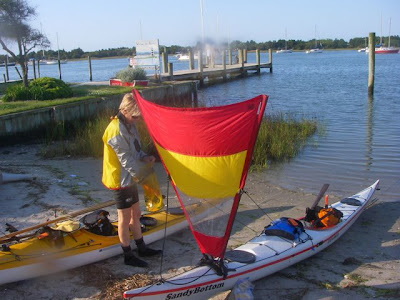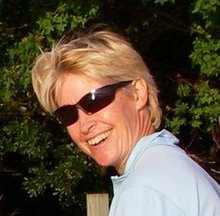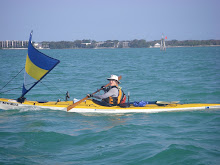 SandyBottom and I had planned a three-day, 100-mile (160km) sea kayak trip to scout for our September WaterTribe North Carolina Challenge (NCC). Using Top Spot chart N239, this is our story, part II…
SandyBottom and I had planned a three-day, 100-mile (160km) sea kayak trip to scout for our September WaterTribe North Carolina Challenge (NCC). Using Top Spot chart N239, this is our story, part II…The sun was just rising as we quickly packed and headed off, paddling across the current, through the Newport Marshes, to the T-junction where the IntraCoastal Waterway meets the channel into Beaufort. Near 0800 we passed aside Beaufort’s drawbridge—being raised at just that time for a couple of large launches—and made our way around the point and into Taylors Creek—with the current.
It’s always a fun time paddling past the Beaufort marine front, with the maritime boat shed, marinas typically full of craft of all sizes and budgets, and someone to wave and say hello.
We pulled into Graden Paul Park, which will be CheckPoint 1 for September’s North Carolina Challenge—a very nice sandy beach for the kayaks, and a solid jetty for the larger boats. It’s a two minute—if that—walk to the nearest café, water and, I remembered, our favourite weekend breakfast brunch, which we took advantage of! Very civilized—though we made sure to sit on the terrace adjoining the marina, upwind of other diners.
 Filling the bladders with another few litres of water, off we headed, nearly salivating with delight with the day's anticipated tail winds—how often does that happen?!
Filling the bladders with another few litres of water, off we headed, nearly salivating with delight with the day's anticipated tail winds—how often does that happen?!Out from Taylors Creek we decided to stay on the outside of Harkers Island to fully take advantage of the sou-wester, blowing a very nice 5-10 knots. Pacific Action Sails up for the broad reach, we ambled past the houses of Harkers, checking out the real estate. Needing a pit stop, we pulled into the Rangers Station at the far end of the island, momentarily confused by the new rip rap wall that now bars you from the entire beach, but offers a wee sheltered inlet to paddle in and make shore.
 Around the tip of Harkers it’s a hard left on a NNE heading, right back up the inner coast of Core Sound toward Cedar Island.
Around the tip of Harkers it’s a hard left on a NNE heading, right back up the inner coast of Core Sound toward Cedar Island.The mantras for the rest of the day, as the winds slowly increased, soon became, from me, “Dawn, you need a rudder”, and from Dawn, “Kristen, I sure do need a rudder”. Relishing the conditions as the wind soon reached 20-22 knots over the afternoon, with the sail up I constantly cruised around 5-6 knots not even paddling, with a regular top speed of 9 knots. But with Core Sound’s shallow waters of just a metre or two off channel, the wind-pushed water can pick up a metre or so breaking chop pretty quickly. And without a rudder to take the pressure off keeping on course, SandyBottom didn’t have it as easy, we finally taking the sails down and completing the day the old-fashioned way.
 Around 1600 we decided to call it quits—primarily because we didn’t want the trip to end too soon—Cedar Island and the finish were only a few hours away, and surely that could wait ‘til morning.
Around 1600 we decided to call it quits—primarily because we didn’t want the trip to end too soon—Cedar Island and the finish were only a few hours away, and surely that could wait ‘til morning.We pulled up at a sandy wind-swept point, lost my hat and spent some very tiring minutes against the wind retrieving it, dragged the boats up into the grasses out of sight, put up tents and changed—and very relaxingly lazed around chatting, waiting for dinner hour, accompanied with a few sips of Glenfiddich.
 It was still quite daylight when we repaired to our tents, each watching the Sound slowly calm as the wind died—though it continued to buffet our tents well into the early hours. And for 12 or so hours, we slept like logs…
It was still quite daylight when we repaired to our tents, each watching the Sound slowly calm as the wind died—though it continued to buffet our tents well into the early hours. And for 12 or so hours, we slept like logs… 
























